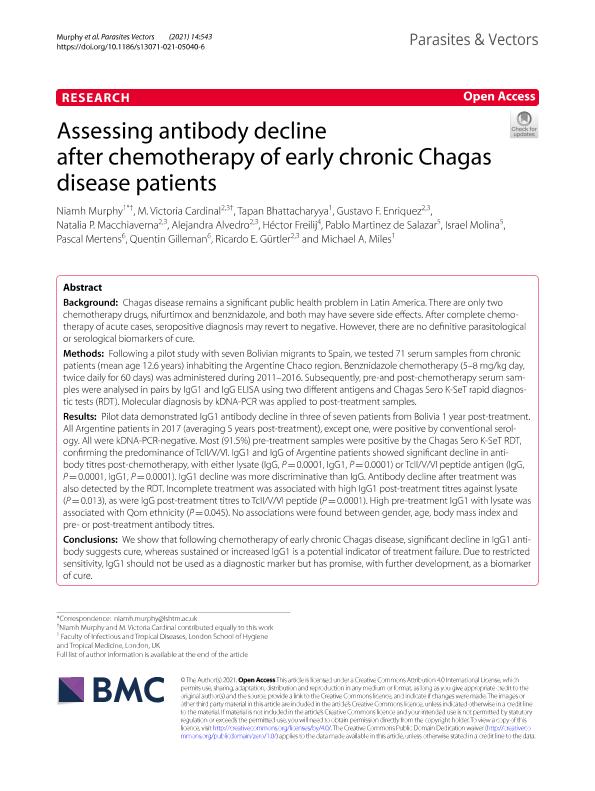Artículo
Assessing antibody decline after chemotherapy of early chronic Chagas disease patients
Murphy, Niamh; Cardinal, Marta Victoria ; Bhattacharyya, Tapan; Enriquez, Gustavo Fabián
; Bhattacharyya, Tapan; Enriquez, Gustavo Fabián ; Macchiaverna, Natalia Paula
; Macchiaverna, Natalia Paula ; Alvedro, Alejandra
; Alvedro, Alejandra ; Freilij, Héctor; Martinez de Salazar, Pablo; Molina, Israel; Mertens, Pascal; Gilleman, Quentin; Gurtler, Ricardo Esteban
; Freilij, Héctor; Martinez de Salazar, Pablo; Molina, Israel; Mertens, Pascal; Gilleman, Quentin; Gurtler, Ricardo Esteban ; Miles, Michael A.
; Miles, Michael A.
 ; Bhattacharyya, Tapan; Enriquez, Gustavo Fabián
; Bhattacharyya, Tapan; Enriquez, Gustavo Fabián ; Macchiaverna, Natalia Paula
; Macchiaverna, Natalia Paula ; Alvedro, Alejandra
; Alvedro, Alejandra ; Freilij, Héctor; Martinez de Salazar, Pablo; Molina, Israel; Mertens, Pascal; Gilleman, Quentin; Gurtler, Ricardo Esteban
; Freilij, Héctor; Martinez de Salazar, Pablo; Molina, Israel; Mertens, Pascal; Gilleman, Quentin; Gurtler, Ricardo Esteban ; Miles, Michael A.
; Miles, Michael A.
Fecha de publicación:
10/2021
Editorial:
BioMed Central
Revista:
Parasites and Vectors
ISSN:
1756-3305
Idioma:
Inglés
Tipo de recurso:
Artículo publicado
Clasificación temática:
Resumen
Background: Chagas disease remains a significant public health problem in Latin America. There are only two chemotherapy drugs, nifurtimox and benznidazole, and both may have severe side effects. After complete chemotherapy of acute cases, seropositive diagnosis may revert to negative. However, there are no definitive parasitological or serological biomarkers of cure. Methods: Following a pilot study with seven Bolivian migrants to Spain, we tested 71 serum samples from chronic patients (mean age 12.6 years) inhabiting the Argentine Chaco region. Benznidazole chemotherapy (5–8 mg/kg day, twice daily for 60 days) was administered during 2011–2016. Subsequently, pre-and post-chemotherapy serum samples were analysed in pairs by IgG1 and IgG ELISA using two different antigens and Chagas Sero K-SeT rapid diagnostic tests (RDT). Molecular diagnosis by kDNA-PCR was applied to post-treatment samples. Results: Pilot data demonstrated IgG1 antibody decline in three of seven patients from Bolivia 1 year post-treatment. All Argentine patients in 2017 (averaging 5 years post-treatment), except one, were positive by conventional serology. All were kDNA-PCR-negative. Most (91.5%) pre-treatment samples were positive by the Chagas Sero K-SeT RDT, confirming the predominance of TcII/V/VI. IgG1 and IgG of Argentine patients showed significant decline in antibody titres post-chemotherapy, with either lysate (IgG, P = 0.0001, IgG1, P = 0.0001) or TcII/V/VI peptide antigen (IgG, P = 0.0001, IgG1, P = 0.0001). IgG1 decline was more discriminative than IgG. Antibody decline after treatment was also detected by the RDT. Incomplete treatment was associated with high IgG1 post-treatment titres against lysate (P = 0.013), as were IgG post-treatment titres to TcII/V/VI peptide (P = 0.0001). High pre-treatment IgG1 with lysate was associated with Qom ethnicity (P = 0.045). No associations were found between gender, age, body mass index and pre- or post-treatment antibody titres. Conclusions: We show that following chemotherapy of early chronic Chagas disease, significant decline in IgG1 antibody suggests cure, whereas sustained or increased IgG1 is a potential indicator of treatment failure. Due to restricted sensitivity, IgG1 should not be used as a diagnostic marker but has promise, with further development, as a biomarker of cure. Graphical abstract: We show that following chemotherapy of early chronic Chagas disease, a significant decline in IgG1 antibody suggests cure, whereas sustained or increased IgG1 is a potential indicator of treatment failure. Due to restricted sensitivity, IgG1 should not be used as a diagnostic marker but has promise, with further development, as a biomarker of cure.
Archivos asociados
Licencia
Identificadores
Colecciones
Articulos(IEGEBA)
Articulos de INSTITUTO DE ECOLOGIA, GENETICA Y EVOLUCION DE BS. AS
Articulos de INSTITUTO DE ECOLOGIA, GENETICA Y EVOLUCION DE BS. AS
Citación
Murphy, Niamh; Cardinal, Marta Victoria; Bhattacharyya, Tapan; Enriquez, Gustavo Fabián; Macchiaverna, Natalia Paula; et al.; Assessing antibody decline after chemotherapy of early chronic Chagas disease patients; BioMed Central; Parasites and Vectors; 14; 1; 10-2021; 1-12
Compartir
Altmétricas



